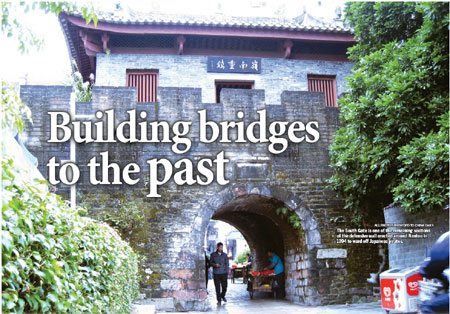Building bridges to the past
Updated: 2012-12-14 07:40
By SL Luo(HK Edition)
|
|||||||
|
The South Gate is one of the remaining sections of the defensive wall erected around Nantou in 1394 to ward off Japanese pirates. All Photos Provided to China Daily |
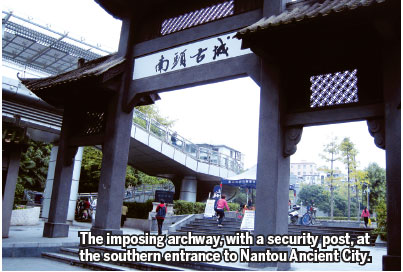
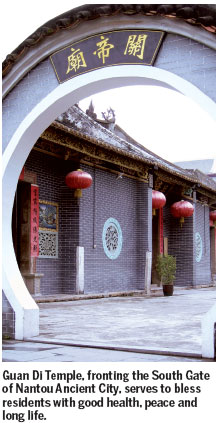
Shenzhen's historic Nantou Ancient City, Hong Kong's 'birthplace', is set to undergo a multi-billion-yuan facelift as a step toward boosting social and cultural ties with HK. SL Luo reports.
Wu Yong greeted me as a comrade of the great Chinese nation, seemingly oblivious to my foreign nationality.
"You've come at another momentous time in our history, a big event for Nanshan, Shenzhen and Hong Kong too," said Wu as he ushered me into his humbly-decorated conference room at the museum next to the spot where Hong Kong was "born" more than one-and-a-half centuries ago.
Wu is director of the Museum of Ancient Fortress on Nantou, which holds and puts on public display thousands of historical items, including excavated artifacts, memorabilia scrolls and documents, as well as antiquity guns and other weapons from as far back as the Ming and Qing dynasties.
The museum, tucked away at Nantou, within walking distance of the bustling nightlife of Nanshan District in southwestern Shenzhen, offers a first-hand glimpse of the 1,700-year history of Nantou, not only for the people of Shenzhen, but also for Hong Kongers as to how their teeming metropolis came into being from near obscurity.
It was at Nantou where officials huddled within the confines of the yamen (government offices) in 1842 to sign off Hong Kong Island to the British, after China lost the Opium War.
Nantou is where Hong Kong has its roots. Founded in 331 AD, it served as the seat of administration as well as a center for transport and trade in the southern China region, extending from Fujian in the east to Zhongshan, Hong Kong and Macao in the south.
Today, Nantou stands as a symbol of its great past, vis-a-vis Hong Kong, with its iconic Nantou Ancient City (also called Xin'an City) housing the historic remains, most having been rebuilt, including the yamen and an original section of the imposing South Gate that was erected in the Middle Ages as a defensive wall to ward off Japanese pirates.
Talking with Wu invokes an incalculable sense of nostalgia, particularly for the hoards of indigenous Cantonese inhabitants of the ancient city, most of whom have moved to Hong Kong or overseas.
Wu has overseen the dramatic transformation of Nantou Ancient City over the years, rising from a "relic" settlement of a few hundred villagers to its current population of about 20,000.
And the old and close bonds between Nantou and Hong Kong are not only here to stay, but to climb to even greater heights.
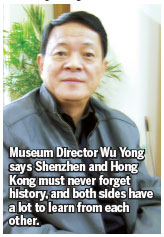
The theme is to turn Nantou Ancient City into an "indispensable corner" for drawing stronger cultural and social ties and to dispel the perception that Shenzhen is "devoid of history."
"Our goal is to narrow the so-called cultural divide between the mainland and Hong Kong, and to encourage more Hong Kong people to come to Nantou to learn about its past and contribute to a more harmonious relationship between the two places," says Wu. "This is our motto for the years to come."
Nantou's historical values and cultural standing have never been in dispute for three key reasons - it was the former administrative heart from where Hong Kong was governed; it's the inseparable cultural bridge for Hong Kong people to learn more about Shenzhen's past; and Nantou was southern China's seat of government in antiquity.
Thus, an ambitious, multi-billion-yuan project to rejuvenate the historic settlement is not something out of the blue. One of the star attractions will be a multi-functional cultural center, to help accomplish those goals in the long run.
"Nantou is the birthplace of Hong Kong, created as the seat of government and nerve center in Dongguan Prefecture. The district is of tremendous significance. It's from here that southern China and Hong Kong were governed before Hong Kong was handed over to Britain.
"The links have been so deep and strong, helping to bring together the different Chinese communities. People would have their grandmothers living in Nantou and their children or siblings in Hong Kong," recalls Wu.
Following Hong Kong's ceding to the British, Nantou remained the military command post for south China and a center of communication with the British rulers.
According to Wu, preparations to kick-start the settlement's facelift have passed the initial stage, with a city-wide public consultation already completed.
The green light from the Shenzhen municipal government is expected next year. "We hope work can begin by mid-2013 under the country's heritage protection regulations," he says.
All existing original or rebuilt structures of cultural interest will be preserved while illegal ones will be removed. The ancient city's current population of 20,000 will be maintained, because there's no space for expansion, unlike other Shenzhen development projects which can be rebuilt and enlarged.
The planned cultural facility will be charged with promoting the strong social and cultural links between Shenzhen and Hong Kong.
"After Hong Kong's return to the motherland, Hong Kong must make its people, especially the younger generation, realize and learn more about Nantou's history and treasure these values," says Wu.
"From Shenzhen's point of view, some people say Shenzhen lacks cultural awareness. We intend to nail this wrong perception.We'll show them that we do have a long cultural history and values. All they have to do is to come to Nantou and see for themselves."
Instances of social conflict between Hong Kong and mainland people may have surfaced in the past, but the general consensus is that such misunderstandings can only dissipate with time as the already close people-to-people relationship can only strengthen further.
Wu is convinced that such links will be cemented and bring great benefit to both sides, particularly on the economic front.
"Following the handover, Shenzhen people visiting Hong Kong are no longer a problem. Shenzhen people have a lot to learn from Hong Kong - in governing and administration techniques, as well as personal behavior and manners," he says.
He has this message for the people of Hong Kong: "As a Shenzhener, I do feel we're now one big family unlike under the British. We're one people all round. We must bridge the divide. We must resolve whatever differences we may have and overcome all our shortcomings. We must never forget history. Nantou is where your roots are."
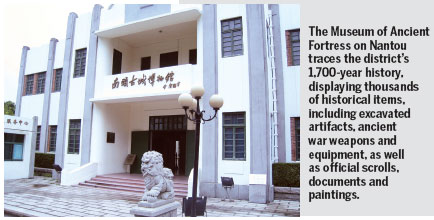
(HK Edition 12/14/2012 page4)
